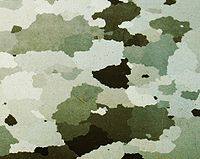
Photo from wikipedia
A biopharmaceutics classification system class IV drug, hydrochlorothiazide (HCT), was combined with co-formers of L-and D-arginine (ARG) and sodium lauryl sulphate (SLS) by cryomilling in 1:1 molar ratio. Co-amorphization was… Click to show full abstract
A biopharmaceutics classification system class IV drug, hydrochlorothiazide (HCT), was combined with co-formers of L-and D-arginine (ARG) and sodium lauryl sulphate (SLS) by cryomilling in 1:1 molar ratio. Co-amorphization was observed with L- and D-ARG. These mixtures showed a single glass transition, evidence of possible salt formation and improved physical stability at elevated temperatures and/or humidity when compared with amorphous HCT. The co-amorphous formulations, along with the combinations of HCT and HCT:L-ARG with polyvinylpyrrolidone (PVP) in 1:1 mass ratio, were investigated with a simultaneous dissolution/permeation setup using parallel artificial membrane permeability assay (PAMPA) or Madine Darby kidney cells (MDCKII) as the permeation barrier. It was observed that co-amorphization with L-ARG and D-ARG was able to induce a supersaturated state for HCT, possibly through intermolecular interactions, but there was virtually no difference between the dissolution properties of the mixtures formed with the two optical isomers of ARG. The permeability of HCT was found to be dependent on the dissolution properties of the formulations in both PAMPA and cellular barrier experiments. Thus, co-amorphization of HCT with L- and D-ARG demonstrated the possibility to enhance the dissolution and thereby the permeation potential of a BCS class IV drug.
Journal Title: Journal of pharmaceutical sciences
Year Published: 2020
Link to full text (if available)
Share on Social Media: Sign Up to like & get
recommendations!